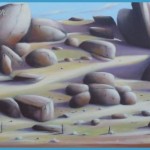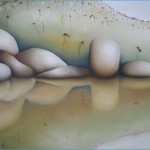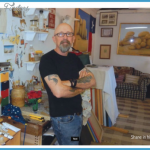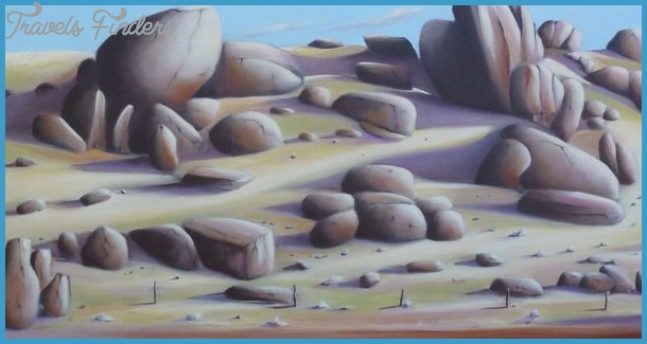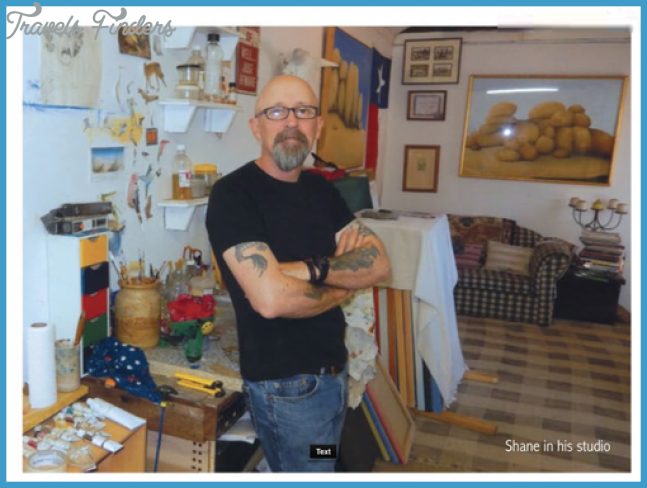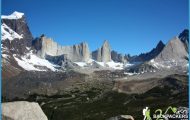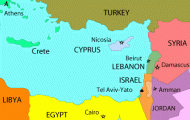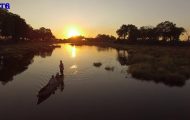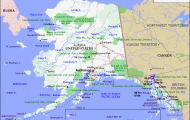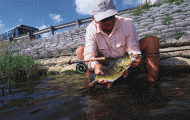Shane Moad’s path into art was certainly not the ‘normal’ course. In 1990, Shane had a bad motorcycle crash that caused major problems with the Neuro system in his body, producing pain throughout for no apparent reason. The injuries sustained in the accident meant that he had to give up his work as a stockman/overseer on Stations in Western Australia. While trying to get a sense of what he could do, Shane took up painting to keep his mind active during the recovery period. “I read a few books at the local library on art, mainly about Australian artists such as Jack Absalom and Arthur Streeton.” “In a short time I was doing small 30cm x 26cm paintings in acrylic. To both my wife Val’s and my own surprise, they were not too bad!” Shane continued to immerse himself in the basics of painting. It was not as easy at first, but seemed to come to him more instinctively than the laboured road he thought he would have. Over the next year, Shane began noticing a complete shift in how he was painting and the way he was using paint. “I tended to work towards a thin layering of the paint, more than the impasto work I had been seeing in books.
Shane Moad Photo Gallery
As I progressed, my technique did the same. Parts of my painting were quite thick and other parts quite thin in the rendering. Using 9cm brushes to move the paint across the canvas to small number one and two riggers, I use whatever is needed. Even sticks, fingers and house painting brushes, basically I do what’s required to get the result I’m looking for within the subject I am painting.” Shane explains that his younger brother, who had studied art at Curtin University, said to him “The best thing that happened to you is that you never went to uni to study art!” Shane believes he was not saying that art school was a bad thing, “just that I was able to fi nd my own style and not be infl uenced by those around me. What he said was true and although he meant it in a broad sense, I could see his point. For me, for better or worse, my style came from my isolation from other artists.” This is one of the reasons, Shane says, he loved working on the Station so much, as the isolation of it appealed to him. “Looking back, it would have been nice to bounce ideas off artists around me, however I am thankful that the isolation allowed me to see the landscape the way I do.” Shane’s approach to painting the landscape is to strip away at it, taking areas that he feels are making the subject ‘too busy’ and leaving them out. “I don’t put every blade of grass or every leaf or tree in, but the viewer is still aware of what they are looking at.”
“Anybody who has spent time in the landscape will know just how diverse a subject it is. I have travelled around diff erent areas of Australia and it is not hard to be inspired. Likewise when my wife and I were in America, visiting family in Texas, my mind was blown away at the vastness of the landscape over there.” “The number one aim for me is to make it my own when I am painting. So I want the viewer to do the same; make the scene their own. I don’t want to tell them the whole story, I want them to let their imaginations guide them through what they are looking at, making it their own experience of the landscape.” Shane states there are many artists that have inspired him over the years. These include American artists, Georgia O’Keeff e, Bonnie Wunderlich, Ed Mell, Edgar Payne and Maynard Dixon, to Australian artists, Tim Storrier, Robert Juniper, Brett Whiteley and John Olsen. “As you can see I am inspired by everyone, from impressionists to abstract. This is one of the reasons I love painting so much, it’s a diverse pursuit!” An important lesson Shane has learnt during his journey is to stay true to your vision. “Many people will have an opinion on your work and that’s good, only if it does not distract you from what you are trying to accomplish. Of course, there are times when constructive criticism is important to listen to. If it is constructive it will help you grow.” For Shane, he describes his work as surrealist to abstracted. “In the United States a number of people who collect my work feel it is very surreal in its nature, but I see it more as semi-abstract.”
Shane says it’s also important to get involved in art shows, especially those that have a pre selection aspect to them. “These sorts of awards normally have well known artists or art critics as judges, so the calibre of judging is normally very high. These days I enter very few competitions, but when I do I make sure they have credibility to them.” Shane has been fortunate to receive many awards from respected judges ranging from Alan R Dodge, past Director of the Art Gallery of Western Australia; David Walker, Adjunct Professor of Art at Curtin University; Robert Cook, Associate Curator of Contemporary Art at the Art Gallery of Western Australia; and well known Australian artist, Robert Juniper. In the twenty plus years Shane has been a professional artist, his work has been collected all over Australia, America, England and Asia. “I love the fact that people have saved to buy one of my works and write to tell me how much they love it. That’s the thrill to me, making someone happy through one of my paintings. Why me instead of so many other good artists out there? I put those questions in God’s hands. I know one reason is because my work is recognisable. Like I said, work towards creating your own style and above all else, enjoy what you are doing.” Shane mentions one last influence he has had during his art career; his wife. “My wife has been of continual support to me, which is impossible to repay. Let’s face it, it is no small task living with a ‘tortured’ artist!” There are currently two galleries which represent Shane, Jah-Roc Galleries in Margaret River and East End Gallery in Beverley, Western Australia. Although Shane still suffers daily from his accident, his commitment to two galleries and commission work keeps him busy and moreover, shows that you can not let life hold you back from achieving your dreams.

